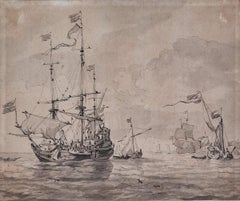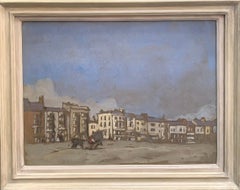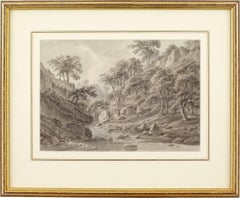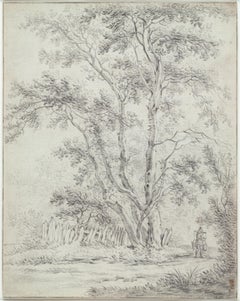Dutch School Landscape Drawings and Watercolors
to
1
2
Overall Width
to
Overall Height
to
2
1,642
1,172
1,049
349
288
95
58
56
49
34
22
18
9
1
1
1
1
1
1
1
1
2
Style: Dutch School
Dutch Men o War Setting Sale In A Fresh Breeze
By Ludolf Bakhuisen
Located in Brecon, Powys
Ludolf Bakhuizen 1631 - 1708
Dutch Men oWar Setting Sale in a Fresh Breeze
Provenance Christies 1998
Pen and Grey Ink and Grey Wash.
Image 5 x 7.25". Fr...
Category
Early 17th Century Dutch School Landscape Drawings and Watercolors
Materials
Ink
Old Master Drawing, Westerkerk Keizersgracht in Amsterdam, 17th century, Dutch
Located in Greven, DE
Jan van der Heyden (1637 Gorinchem - 1712 Amsterdam), attributed.
Old Master Drawing, Westerkerk Keizersgracht in Amsterdam, 17th century, Dutch
Westerkerk and Keizersgracht in Amsterdam
Backside: later drawn backside with village church of the 18th century
Chalk and pen on paper
23,5 x 18,5 cm
Preliminary drawing for a painting from the creative period c. 1667 - 1670. This painting has been published a few years ago by Peter C. Sutton in the catalogue raisonné of the artist.
Van der Heyden was initially a pupil of a glass painter, but later turned exclusively to architectural painting and went to Amsterdam, where he painted views of churches, castles, palaces, public squares, streets, canals, etc., most of which are richly decorated with staffage. In addition, van der Heyden was also active as an inventor, for example, he developed a street lighting system for Amsterdam by means of oil street lamps, which was in operation from 1669 to 1840. After a stay in London, he painted the London fire of 1666, which he either witnessed himself or had seen the consequences of. Certainly influenced by this, he did much to further the technical and organisational development of the fire brigade from 1669 onwards. His greatest invention was probably the fire hose, which enabled significant improvements in fire-fighting technology and tactics. He also improved the hand-operated fire engines of the time by making them smaller, more mobile and more powerful, and he developed the series connection of several pumps to increase the pressure in order to achieve a greater range for the water jet. In 1690, together with his son, he was the author and illustrator of the Brandspuiten-boek, the first manual for fire fighting.
Johann Lingelbach, Adriaen van de Velde and Eglon van der Neer...
Category
17th Century Dutch School Landscape Drawings and Watercolors
Materials
Paper, Chalk
$1,820 Sale Price
20% Off
Related Items
Littlehampton Watercolour Early 20th Century
Located in London, GB
Horace Mann Livens
1862 - 1936
Littlehampton
Watercolour, gouache, and black chalk on paper, signed and dated '10' lower left
Image size: 11 ¼ x 15 inches (28.5 x 38 cm)
Acid free mo...
Category
Early 20th Century Dutch School Landscape Drawings and Watercolors
Materials
Paper, Chalk, Watercolor, Gouache
Amos Green, Near Ingleton, Yorkshire
Located in Cheltenham, GB
This fine early 19th-century watercolour by British artist Amos Green (1735-1807) depicts an asperous gorge near Ingleton in Yorkshire.
On either side of a shallow river, trees clin...
Category
Early 1800s Dutch School Landscape Drawings and Watercolors
Materials
Watercolor, Ink, Paper
'Dawn Lake (Blue Ridge Mountains)' Landscape blue water natural pastel
Located in Penzance, GB
'Dawn Lake (Blue Ridge Mountains)'
Original Artwork. Unframed
______________
The dawn is painting transient layered reflections in the water, shifting the softened space between whe...
Category
2010s Dutch School Landscape Drawings and Watercolors
Materials
Paper, Conté, Ink, Mixed Media, Acrylic, Pencil, Carbon Pencil
$4,154
H 22.05 in W 31.11 in
Modernist Conte Crayon Drawing Beach Scene David Burliuk Russian Futurist
Located in Surfside, FL
David Burliuk (Ukrainian, 1882-1967)
Three figure on the beach (Hamptons, Long Island New York)
Conte crayon drawing on paper.
Hand signed lower left.
Unframed
Provenance: Bloomsbury Auctions
David Davidovich Burliuk (Дави́д Дави́дович Бурлю́к; 1882-1967) was a Russian poet, artist and publicist of Ukrainian origin associated with the Futurist and Neo-Primitivist movements. Burliuk has been described as "the father of Russian Futurism."
David Burliuk was born on 21 July 1882 in the village of Riabushky (near Lebedyn, Ukraine) in the Kharkov Governorate of the Russian Empire. Burliuk's family was artistically inclined; two of his brothers were talented artists as well, Nikolai and Volodimir Burliuk. The Burliuk family partly descended from Ukrainian Cossacks on their father's side, who held premier positions in the Hetmanate. His mother, Ludmyla Mikhnevich, was of ethnic Belarusian descent.
From 1898 to 1904, he studied at Kazan and Odesa art schools, as well as at the Royal Academy in Munich. His exuberant, extroverted character was recognized by Anton Azhbe, his professor at the Munich Academy, who called Burliuk a "wonderful wild steppe horse". During a time of significant industrialization and political change, movements such as the famed Der Blaue Reiter, a group Burliuk associated with in 1912, while he was in Munich, emphasized a shift away from the classical styles of the past, prioritizing the innovations of the future.
In 1907, he made contact with the Russian art world; he met and befriended Mikhail Larionov, and they are both credited as being major forces in bringing together the contemporary art world. In 1908, an exhibition with the group Zveno ("The Link") in Kiev was organized by David Burliuk together with Wladimir Baranoff-Rossine, Alexander Bogomazov, his brother Volodymyr (Wladimir) Burliuk and Aleksandra Exter. The exhibition was a flop, especially because they were all unknown painters. The Burliuks and Larionov left for the aforementioned brothers' home in Chernianka, also known as Hylea; it was during this stay that their work became more Avant-Garde. That autumn, while visiting Ekster, they organized an exhibition which took place in the street; it was a success, and enough money was raised to go to Moscow.
In 1909, Burliuk painted a portrait of his future wife, Marussia, on a background of flowers and rocks...
Category
Mid-20th Century Dutch School Landscape Drawings and Watercolors
Materials
Paper, Conté, Crayon
Part of the ring-wall of the Taj Mahal, Agra, India, 1914
Located in Amsterdam, NL
Part of the ring-wall of the Taj Mahal, Agra, India, 1914
Signed with initials and dated bottom right
Black chalk on paper, 45.5 x 53 cm
Literature:
Ernst Braches en J.F. Heijbro...
Category
1910s Dutch School Landscape Drawings and Watercolors
Materials
Paper, Chalk
$22,996
H 17.92 in W 20.87 in D 1.19 in
'Omvetya I'. Blue white ocean landscape abstract nature drawing
Located in Penzance, GB
'Omvetya I (Prye, Rising Tide)'
Original Artwork. Unframed
______________
Softly dancing seaweed, patiently awaits the return of the salty sea to fill the tidal pools. Created outdo...
Category
2010s Dutch School Landscape Drawings and Watercolors
Materials
Paper, Conté, Mixed Media, Pencil, Carbon Pencil, Photogram
$681
H 7.88 in W 10.04 in
'Omvetya II'. Blue white shore ocean landscape abstract nature drawing
Located in Penzance, GB
'Omvetya II (Cargeen, Towards Treryn Dinas)'
Original Artwork. Unframed
______________
Softly dancing seaweed, patiently awaits the return of the salty sea to fill the tidal pools. ...
Category
2010s Dutch School Landscape Drawings and Watercolors
Materials
Paper, Conté, Mixed Media, Pencil, Carbon Pencil, Photogram
$681
H 8.27 in W 5.91 in
'Omvetya III'. Blue white shore ocean beach cottage abstract nature drawing
Located in Penzance, GB
'Omvetya III (Sea Carrots, Sennen)'
Original Artwork. Unframed
______________
The evening light is drawing low soft shadows in the dunes at the salted edge of the Atlantic. 'Omvety...
Category
2010s Dutch School Landscape Drawings and Watercolors
Materials
Paper, Conté, Mixed Media, Pencil, Carbon Pencil, Photogram
Old Tree and September Wind Clouds
Located in New York, NY
Old Tree and September Wind Clouds, 1961, by Charles Burchfield (1893-1967)
Conte crayon on paper
13 ½ x 19 ½ inches unframed (34.29 x 49.53 cm)
19 ¾ x 25 ½ inches framed (50.165 x 6...
Category
1960s Dutch School Landscape Drawings and Watercolors
Materials
Paper, Conté
Landscape - Drawing Ink by Eugen Drăguțescu - Mid 20th Century
Located in Roma, IT
Landscape is an original drawing in china ink realized by Eugen Drăguțescu.
Hand-signed
Good conditions with some stains.
The artwork represents a landscape in a well-balanced com...
Category
Mid-20th Century Dutch School Landscape Drawings and Watercolors
Materials
Ink
$479
H 6.7 in W 9.45 in D 0.04 in
Plants - Original China Ink Drawing by Jan Pieter Verdussen - 1740
Located in Roma, IT
Plants is a beautiful artwork realized by Jan Peter Verdussen in 1740.
pen and watercolour on brown paper. In good codition except for some pencil marks and traces of sealing wax on...
Category
Mid-17th Century Dutch School Landscape Drawings and Watercolors
Materials
Paper, Ink
$1,077
H 6.7 in W 9.06 in D 0.04 in
French Romantic school, View of a citadel, pen and watercolor
Located in Paris, FR
French Romantic school, 19th century
View of a citadel
Pen and ink, watercolor and heightenings of white gouache on brown paper
18 x 29.5 cm
In good condition, some stains and traces...
Category
1850s Dutch School Landscape Drawings and Watercolors
Materials
Ink, Watercolor
$389 Sale Price
30% Off
H 7.09 in W 11.62 in
Previously Available Items
Landscape Drawing, Old Master, 17th Century, by Van Nikkelen, Dutch Golden Age
Located in Greven, DE
Landscape with tree and water-bearing farmer
Black chalk on paper
Sheet 30.2 x 24 cm
Plain gold moulding, 48 x 41.3 cm
Van Nickelen was a successful artist in the 17th century Netherlands...
Category
17th Century Dutch School Landscape Drawings and Watercolors
Materials
Paper, Chalk
Dutch School landscape drawings and watercolors for sale on 1stDibs.
Find a wide variety of authentic Dutch School landscape drawings and watercolors available for sale on 1stDibs. Works in this style were very popular during the 18th Century and Earlier, but contemporary artists have continued to produce works inspired by this movement. Frequently made by artists working with Chalk, and Paper and other materials, all of these pieces for sale are unique and have attracted attention over the years. Not every interior allows for large Dutch School landscape drawings and watercolors, so small editions measuring 7.29 inches across are also available. Prices for landscape drawings and watercolors made by famous or emerging artists can differ depending on medium, time period and other attributes. On 1stDibs, the price for these items starts at $1,639 and tops out at $1,639, while the average work sells for $1,639.



